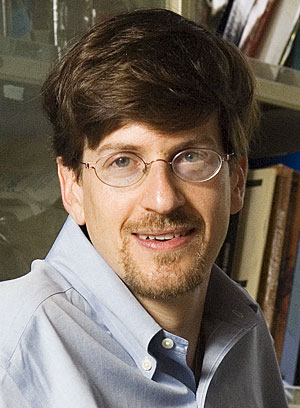Keck grant funds brain-imaging effort
BY LOUIS BERGERON
Tantalizing treasures of neural knowledge that lie deep in the brain of the common fruit fly are one step closer to being laid bare, now that a team of six Stanford researchers has been awarded a $1.3 million medical research grant by the W. M. Keck Foundation.
The project being funded, massively parallel brain imaging, is a cross-disciplinary effort led by Mark Schnitzer, assistant professor of biology and of applied physics.
The researchers' goal is to develop a mathematical understanding of the engineering principles governing the operation of neural circuits—knowledge that likely will reverberate far beyond the tiny cranial cavity of a fruit fly, as it yields insights into brain function, animal behavior and brain disease.
"Over the last decade, flies have become an increasingly important model in the study of brain disease," Schnitzer said. "There are fly models of neurodegenerative disorders, of behavioral disorders, and there have been longstanding models of neurodevelopmental disorders."
The structure of the neural circuitry in fruit fly brains is very consistent from one fly to the next, which makes them ideal subjects for this type of study.
By using a laser-based form of imaging known as two-photon microscopy, the team will be able to observe a fly's neural responses to various external stimuli. That's the brain-imaging part of the study.
But what gives their proposal its biggest punch is the plan to design a device to split a single laser beam into 96 beams, each penetrating the brain of an individual fly, so that the scientists can observe all 96 fly brains simultaneously. That's the massively parallel part of the study, and the two-orders-of-magnitude leap forward in the rate of data gathering that is key to reaping the real rewards.
"That increase in speed translates in practice into whole new kinds of experiments that can be done," Schnitzer said. "We aim to make systematic studies of the fly nervous system, in which we examine a large number of subjects, each with slightly different perturbations to the brain."
Methods to genetically manipulate fly brains already exist, allowing the researchers to induce a broad range of perturbations to fly circuitry. They can then observe the neural responses to various visual and olfactory stimuli, thereby gaining insights into the process by which sensory cues guide motor actions.
Ultimately, they hope to develop an understanding of how multiple brain circuits work cooperatively to shape complex behavior, Schnitzer said.
"The Keck Foundation support will be instrumental in allowing us to explore and develop this new technology," he said. "We're very grateful for their willingness to support this kind of nontraditional project."
The other investigators are Thomas Baer, senior research scientist and consulting professor of applied physics at the Photonics Research Center; Mark Horowitz, the Yahoo! Founders Professor of Electrical Engineering and of Computer Science; Liqun Luo, professor of biology; Thomas Clandinin, assistant professor of neurobiology; and Matthew Scott, professor of developmental biology, of genetics and of bioengineering.
"This project really capitalizes on the strengths of Bio-X, as it's a very collaborative project," Schnitzer said, referring to Stanford's interdisciplinary program in bioscience.
Schnitzer and Clandinin were both winners of Pioneer Awards from the National Institutes of Health in 2007 for individual proposals they submitted.
Based in Los Angeles, the W. M. Keck Foundation was established in 1954 by the late W. M. Keck, founder of Superior Oil Co. The foundation's grant making is focused primarily on pioneering efforts in the areas of medical research, science and engineering. The foundation also maintains a Southern California Grant Program that provides support in the areas of civic and community services with a special emphasis on children. For more information, visit http://www.wmkeck.org.






